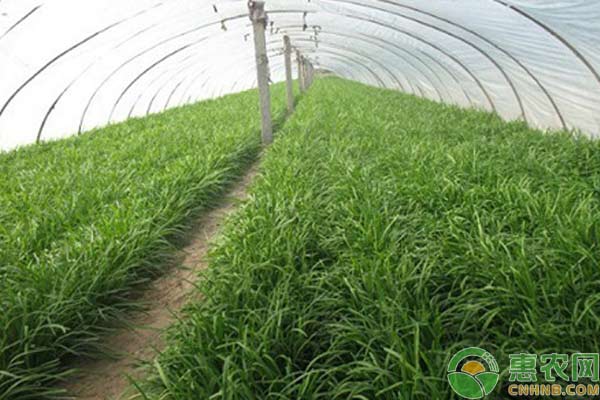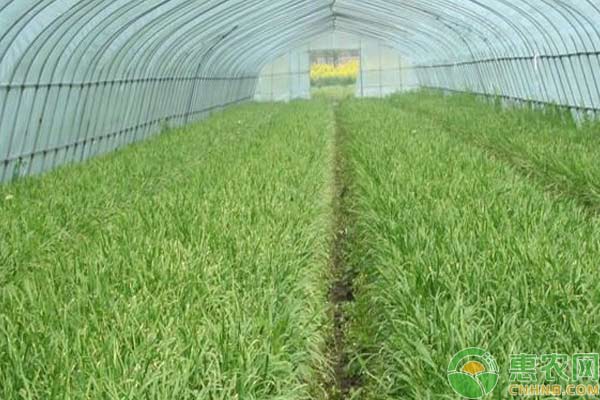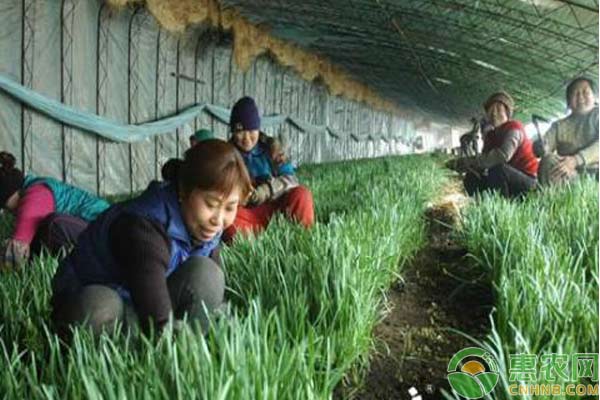With the growing maturity of greenhouse cultivation techniques, many fruits and vegetables can be grown in greenhouses. It is also not surprising that we can eat watermelon in the cold winter because of the greenhouse cultivation technology. A kind of vegetable that everyone is familiar with, it has the functions of stomach, refreshing, antiperspirant and firming. In Chinese medicine, some people call it a leek. So let's take a look at the cultivation techniques for greenhouse leek.

1 variety selection
The leeks cultivated in the greenhouse should be selected from the varieties with wide leaves, thick green leaves, erect leaves, short dormancy, good commerciality, fast growth and strong disease resistance.
2 cultivation methods
Mainly based on live broadcast, planted in the same year, buckled in the same year, harvested that year. Followed by seedlings. Both methods are rooted in summer and autumn, covered in winter and spring, and can be replanted after 1 to 3 years.
3 sowing period
Seedlings are generally sown from late April to early May, that is, “Guyu†to “Lixia†is the best sowing date. After sowing, the germination rate is high and the emergence is fast. At the same time, transplanting at this time, the live broadcast should be covered with a double-arched double membrane, and planted 2 months earlier to extend the cultivation time of the root strain and increase the yield of the current year.
4 Fertilization
After the harvest of the first crop in the first year of autumn, deep ploughing and drying the soil, lying on the autumn fertilizer, applying 8000kg of high-quality rotted farmyard manure (the best for sheep manure) per 667m2, 300~400kg of slag oil, 100kg of phosphate fertilizer, filling the bottom water , 耙耱 墒 墒.
5 planting methods
The live broadcast adopts wide strip method, the line spacing is 35~40cm, the broadcast width is 12~15cm, the ditch depth is 8~10cm, the bottom of the ditch is pushed flat, and the selected seeds are put into the metal tank with many small holes at the bottom and shaken evenly. The seeding rate is 23 to 5 kg per 667 m (depending on the variety of tillering power and seed germination rate as appropriate). After the seeds are spread, cover 2 to 3 cm of fine soil in time, then step on it with your feet, and then cover the sand with a layer of sand to facilitate emergence. In order to emerge early, it is also possible to soak seeds and germination, and then re-broadcast. The method is to soak seeds in warm water at 30 ° C for 24 hours, remove the sorghum seeds, wash the mucus, filter off the water, cover the wet towel and place it in the environment of 15-20 ° C for 3 to 5 days, and wash it with water for 1 to 2 times a day. After the seeds are exposed, they are moved to a “clam bud†at 10-15 °C, and 80% of the seeds are germinated and then sown (not to be trampled after sowing).
Seedling transplanting is carried out by ditching, with a row spacing of 33-35 cm and a ditch depth of 10-12 cm. Pick up the good seedlings, and cut the roots to about 10cm. Leave the leaves 3~4cm from the tillers and place them in the shade. Plant them in the open ditch. The distance between the leaves is 20cm and the temperature is 30~40. The plant is distributed in a long strip shape, planted and compacted, and watered in time until it survives. If there is a lack of seedlings, quickly replant.

6 Field management
6.1 Seedling management Before and after emergence, the soil will be poured with the soil, keeping the ground moist, in order to facilitate the emergence of seedlings and emergence. Use the arch shed to sown, pay attention to ventilation after emergence, keep 15 ~ 20 °C during the day, 10 ~ 12 ° C at night, after the night frost after the shed. Timely weeding, watering, loosening, when the seedlings are weak, 20kg of diammonium phosphate can be applied every 667m2.
6.2 Autumn tube rooting into the autumn After the growth of leeks, the key is to cultivate the root system. It is necessary to strengthen management and attach importance to topdressing. In August, 20 to 30 kg of urea was applied per 667 m2 in combination with watering. In September, 200 to 300 kg of oil residue per 667 m2 or 2000 to 3000 kg of high-quality farmyard fertilizer was used. After October (cold dew), water control seedlings were controlled to prevent the glutton from delaying dormancy.
6.3 Prevention of roots and jealousy of feces. It was found that the root can be rooted with an agent such as 80% dichlorvos or 90% trichlorfon 1000 times liquid.
7 buckle film time
Henan 791, Hangzhou ferrets with short dormancy period, the leaves can be buckled before and after the leaves are wilted, you can cut a knife before the end of 10 days (at the end of October), and then buckle the membrane. The long-term sleep period of Shaanxi Maji and Hanzhong Dongyu is subject to the film production after the upper part of the ground is withered (ie, in mid-November). Before the film is buckled, remove the dead leaves of the stems and fill the winter water. After the water seepage, apply 2000~3000kg of farmyard manure per 667m2.
8 temperature regulation
Amaranth grows at a suitable temperature of 12 to 24 °C. After clearing or harvesting, the temperature can be increased to 25-30 °C to promote rapid seedling growth. After the loquat leaves are unearthed, the temperature is strictly controlled. During the daytime, the temperature is 17~24°C, and the night temperature is not lower than 10°C. The temperature is 3~5°C before harvesting, and the temperature is lowered by 2~3°C to improve the quality. At the beginning of the shed, strengthen the ventilation and ventilation, and the grasshoppers should be properly exposed.
9 irrigation and topdressing
After the film is buckled, the irrigation should not be excessive. It is necessary to irrigate water 5 to 7 days before harvesting. The purpose is to increase the yield and create conditions for the growth of the lower leeks. Watering immediately after cutting is easy to cause the leeks to rotten. In combination with watering, urea or diammonium phosphate (215 to 20 kg per 667 m) can be applied in an appropriate amount.
10 soil and bauxite
When the leeks are as high as about 10cm, the soil is started on the basis of the pre-stage ripper, and the soil is 3-4cm each time (not more than the branching of the leaves). The soil is cultivated 2 to 3 times, and the final cultivation is about 10cm. Small ridge. The purpose is: first, soften the pseudo stem, optimize the quality; second, it is conducive to furrow irrigation, water does not leak; third is anti-leaf, erect growth; fourth, the leaf clump can be gathered in the ridge, which is favorable for ventilation and light, and raises the ground temperature. Reduce disease, plant robust and easy to harvest. For the leeks deep-grooved, it is necessary to smash the soil in time to improve the ground temperature and promote growth.
11 leeks harvesting
11.1 After the film is released to the first knife harvest time, the first knife is harvested. It takes 40 to 50 days under normal management conditions. However, if the indoor temperature cannot be effectively controlled, the high temperature will make the head knife amaranth in 15-20. Growing in the day, at this time, the harvest, the price is low, the nutrients consumed in the leek bulbs can not be fully replenished, affecting the yield of the subsequent knives.
11.2 Harvesting Times and Intervals The greenhouse leeks can cut up to 4 to 5 knives in winter and spring. The leeks that are about to be replaced are replaced by 1 to 2 knives. According to the relationship between the operation of the leek and the underground nutrient, the interval between the two knives should be about one month at the time of harvesting, and the best harvesting period is when the plants reach 4 to 5 leaves. The interval between harvests is too short, which will cause the leek to decline and reduce production. In severe cases, it will be cut off.
11.3 Harvesting methods Live or transplanted leeks are often harvested with a shovel. Harvesting stubble height should be appropriate, too high impact on yield, too low damage to leek. Generally, it is suitable to harvest from 3 to 5 cm above the bulb. The cut is yellow and white, the green and white are too shallow, the white is too deep, and the "horsehoe" shape will hurt the roots. Harvesting time should be in the morning and evening, the best harvest before the grass is uncovered in the morning, the leeks are tender and not wilting, and it is not easy to heat and yellow after packaging.

Harvesting of greenhouse leek is completed. In mid-April, the film can be transferred to open field management and the root strain can be continued. From April to June, the fertilizer was applied twice in combination with watering (20 kg per 667 m2 or 20 kg diammonium phosphate). Canola can also be harvested in summer, but it is not advisable to harvest green barley. In particular, we must pay attention to the roots of autumn management and lay a good foundation for covering production next year. Generally, it takes about 3 years to continuously change the roots.
About the cultivation techniques of leeks in the greenhouse, it is introduced here. In fact, leeks are a kind of vegetable that is well grown. As long as the cultivation techniques are right, there are endless leeks.
In China, nervous system drugs are also one of the drugs with the most rapid sales growth in recent years. In 2002, nervous system drugs occupied 5.9% of the entire pharmaceutical market share, and the total sales amount increased by 9.4%.
With the increasing trend of urbanization and aging, the elderly population in China has exceeded 120 million, and the incidence of geriatric diseases, especially mental diseases, is increasing year by year. With the increase of residents' income, the elderly's requirements for quality of life also increase. As a result, the demand for drugs to treat mental illnesses such as Alzheimer's has soared. In WHO drug classification, psychotropic drugs and nootropic drugs are grouped into one class. We briefly analyzed the development trend of this class of drugs through the clinical drug use data collected from more than 300 domestic key hospitals by Chinese Pharmaceutical Association.
The overall market size of this class of drugs is about 1.22 billion yuan, the consumption sum increased by 5.0% in 2002, but the sales quantity increased by 11.2%. The main reason why the consumption sum did not increase with the sales quantity is that several main varieties of this class of drugs, such as piracetam, cobalt bin amide and ginkgo biloba leaf, etc. In 2002, the price of selling units fell sharply due to bidding. Among these drugs, ginkgo biloba preparation occupies the largest market share, accounting for more than 1/3 of the market share, ganglioside ester and cobalt bin amide combined also occupy nearly 1/3 of the market share, piracetam and other "sitan" drugs occupy nearly 10% of the market share, the rest of the drugs occupy less than 5% of the market share. At present, more than 20 ginkgo leaf production enterprises, piracetam production enterprises more than 70, have entered the stage of price competition, profit repeatedly diluted.
In the first-line varieties, except ginkgo biloba leaves preparation maintained vigorous vitality, the growth of other varieties were weak, especially the traditional variety piracetam suffered from bidding
buy nootropics,nootropics benefits,nootropics for adhd,nootropics for weight loss,nootropics supplements
Shaanxi YXchuang Biotechnology Co., Ltd , https://www.peptide-nootropics.com